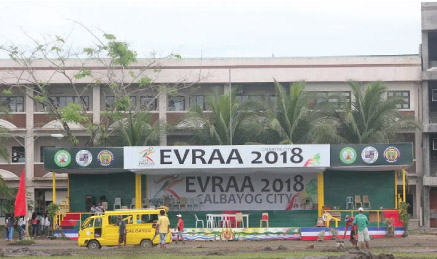TACLOBAN CITY- A soldier and a woman were among the arrested individuals during separate buy-bust operations conducted by the Philippine Drug Enforcement Agency (PDEA) and anti-illegal drug unit of the Philippine National Police in Leyte.
Arrested were Janice Pacomo, 35; Joseph Reazon, 31; and Jerry Delgado, a soldier, who are all now detained at the detention center of the PDEA-8.
In his report to PDEA Director General Aaron Aquino, PDEA Regional Director Edgar T. Jubay, said that the separate buy-bust operations resulted in the seizure of nine sachets of suspected shabu with an estimated street value of P11,500.
Seized from Pacomo during the sting operation in Barangay 91 at about 2:30 pm last February 5, were five sachets of shabu valued at P5,000 weighing 1.0 grams while same weigh of shabu was confiscated from Reazon during a separate buy-bust operation at San Roque, Alangalang, Leyte of the same day.
Another buy-bust operation conducted by the PDEA personnel together with the anti-illegal drug unit of the PNP-Leyte of Feb.5 resulted in the arrest of Delgado, 53 and identified to be a soldier.
Delgado, a resident of Sagkahan district, this city, was arrested in the vicinity of Borderline, a hotel located in Barangay Pawing, Palo town.
Confiscated from the suspect were three sachets of shabu weighing 0.3 grams valued at P1,500.
All suspects were charged with illegal possession and selling of an illegal drug. (PR)
Soldier, woman arrested in separate sting operations conducted by PDEA
Mayor Cristina inspires Tacloban athletes in this year’s EVRAA Meet
CALBAYOG CITY- Tacloban City Mayor Cristina Romualdez was in the city to personally give her moral support to the young athletes from the city who joined this year’s Eastern Visayas Regional Athletic Association (EVRAA) Meet held here.
Mayor Romualdez attended the opening rites of the EVRAA 2018 held at the grounds of the Northwest Samar State University together with other officials of the region.
She was welcomed by Calbayog City Mayor Ronaldo Aquino and Samar Rep. Edgar Mary Sarmiento.
“My presence (here) is to boost the fighting spirit of our Tacloban athletes that they give their best in said EVRAA sports competition,” she said.
Mayor Romualdez likewise wished all the delegates representing the different provinces and cities of the region to aspire for the championship awards.
The Tacloban city mayor is also the regional chair of the Regional Development Council. (GAY B. GASPAY, TISAT Media Bureau)
CSC Chair Bala attends blessing of field office in Leyte
The Civil Service Commission (CSC) Regional Office No. VIII recently conducted the inauguration and blessing of its newly constructed Field Office buildings for its Southern Leyte Field Office in Maasin City, Southern Leyte and Biliran Field Office in Naval, Biliran last January 25 and also for its Leyte Field Office II in Palo, Leyte on January 26, 2018.
Gracing the event were the Commission Officials composed of CSC Chairperson Alicia dela Rosa-Bala, Commissioner Robert S. Martinez and Commissioner Leopoldo Roberto W. Valderosa Jr., together with Director IV Victoria F. Esber and other CSC Region VIII officials and employees.
In her keynote message during the blessing, Chairperson Bala said, “A blessing is something to thank for. This means that this is the start of better days ahead for the Commission. This is not just an office but also a home for civil servants and it was built for our clients. It not only brings the services closer but it would also be a new home where the staff would be more productive and discuss the policies of the commission to the HRM Practitioners”.
CSC Chairperson Bala thanked the different local government units and national government agencies that partnered with the CSSC in the construction of the buildings.
The new CSC Field Office buildings would cater to the needs of its clients and as well as to the Human Resource Management Practitioners within their jurisdiction.
(BRIEL U. TURIJA,Human Resource Specialist I/PR)
DILG to conduct debates on federalism among students in EV
TACLOBAN CITY- The Department of Interior and Local Government (DILG) here in the region conducted a preliminary meeting on a debate on federalism held at its training center, on Tuesday (February 6).
The DILG has been tasked by President Rodrigo Duterte to lead the information and education campaign on federalism.
In response, the regional office, under Director Maribel Sacendoncillo, crafted its work to promote awareness and discussion on federalism as a mode of government.
The debate, with college students participating, will seek to promote a culture of discussion on federalism and relevant issues among the various audiences tuning in.
The 15 match debate will include 16 collegiate teams from all over the region competing in a single elimination match, shielding survivors through quarterfinals, semi-finals, until the grand finals to crown the regional champion.
The target audiences in the series of a debate are young people from 18-35 years old.
The debate will be composed of at least 16 teams competing in the preliminaries with four teams from Tacloban-Palo where most of the biggest colleges and universities are located such as the Leyte Normal University (LNU); Eastern Visayas State University (EVSU); University of the Philippines Visayas Tacloban Campus (UPVTC), and St. Paul’s School for Professional Studies (SPSPS).
One team will be coming from Visayas State University (VSU) in Baybay City; Naval State University (NSU); Southern Leyte State University (SLSU) in Maasin City; Samar State University (SSU) in Catbalogan City; Northwest Samar State University (NSSU) in Calbayog City and University of Eastern Philippines (UEP) in Catarman, Northern Samar.
Winners at the preliminaries, quarterfinals, and semi-finals will be given medals, cash prizes, and certificates while the grand winners will receive a trophy for their school as well as cash prizes and medals for team members.
DILG provincial offices are directed to coordinate with universities and colleges, an influential radio station including the IBP chapter in their areas to implement the contest. (JESSICA A. OLEVO LNU Student Intern)
Let the games begin


CALBAYOG CITY- More than 8,000 student-athletes across the region are to plunge into actions as this year’s Eastern Visayas Regional Athletic Association (EVRAA) Meet is to begin on Sunday (Feb. 4) in this city.
Delegations started arriving here since January 30 for purposes of familiarization of the playing venues.
The regional sporting event will start with a thanksgiving mass and a press conference in the morning, with the parade and opening ceremonies in the afternoon to be held at the grounds of the Northwest Samar State University.
More than 400 police and soldiers are to be deployed in the streets and in all billeting areas to ensure the safety of the delegations and the visitors during the entire EVRAA Meet staging.
Almost 4,000 students and teachers are to perform the unity dance, drum and bugle corps and grand chorale during the opening program.
This is the third time Calbayog City will host the regional athletic event, the last one in 2011.
Raul Agban, city schools division superintendent, is hopeful that this year’s staging of EVRAA in this city will be successful just like its previous hosting.
“DepEd worked hand in hand with the local government of Calbayog, for our successful hosting of EVRAA because the hosting is not only for DepEd but for the entire city,” he said.
Education Assistant Secretary for Procurement, Project Management, and Field Operations Revsee Escobedo will be the guest speaker during the opening rites.
Samar Rep. Edgar Mary Sarmiento(1st district) and City Mayor Ronaldo Aquino are to welcome the delegations from all over the region.
Classes in the entire city will be suspended starting February 5 to give the students opportunity to witness the different sports events. Teachers were also assigned to extend assistance to each delegation.
For the staging of the 2018 EVRAA Meet, the city government allocated P35 million.
“We made sure that everything is prepared for this year’s EVRAA Meet in Calbayog,” City Mayor Aquino said.
The city assigned a medical in each delegation to look into the health of the athletes.
Aside from the military, personnel from the Philippine National Police, Coast Guard, Calbayog Public Order and Safety Office, and City Disaster Risk Reduction and Management Office will look into the security and orderliness in all the billeting venues.
Meanwhile, Rep. Sarmiento commissioned motorized cabs locally known as “timbol” or “taxicol” to ferry members of the delegations or those who will witness the sports events in the different playing venues.
“We want the members of each delegation coming from the different parts of the region feel at home in our city. By giving them the free ride is one way of making their stay in Calbayog easy for them in going to different playing venues,” the solon said.
Meantime, city and provincial tourism offices will also join this year’s EVRAA Meet. Tourism Expo is set to open on February 5 showcasing the different tourist destinations in the region.
“We are happy that the city and provincial tourism offices of each delegation has responded to our invitation to join the Tourism Expo,” city tourism officer Ronald Ricafort said.
Ricafort also added that their office will give a P50 discount to members of the delegation who will ride the zipline.
Meanwhile, more than 400 police and soldiers are to be deployed in the city during the entire staging of the EVRAA to ensure the safety of the delegates and the visitors.
“Together with our counterparts coming from the AFP, Coast Guard, we will make sure of the security of our delegates,” P/Supt. Jose Junar Alamo, Calbayog City police chief, said.
By: JENNIFER SUMAGANG ALLEGADO
TRAIN Law hits civil registry documents fee
Fees increase effective Friday
TACLOBAN CITY- Even securing civil registry documents have been hit by the TRAIN Law.
Effective last Friday (February 2), fees on the issuances and authentications of birth, marriage and death certificates as well as certificate of no marriage (Cenomar) from the Philippine Statistics Authority (PSA) will go up due to the implementation of the Tax Reform for Acceleration and Inclusion (TRAIN) Law which took effect on January 1 of this year.
Nikki Joy Belas, information officer of PSA-8, based here, said that an increase of P15 will be imposed for those who will secure of these civil registry documents from their office effective this Friday.
From the previous P140, those who will secure birth, marriage and death certificates, they now have to pay P155 per copy while for the issuance of Cenomar, one has to pay P210 from the current rate of P195.
“The increase of the new rate effective February 2 is based on the implementation rules and regulations of BIR (Bureau of Internal Revenue) Revenue Regulations No.4-2018 for documentary stamp tax rate adjustment due to the TRAIN Law,” Belas said, citing the reason for the increase of the fees.
The implementation of the TRAIN Law resulted in the amendments of several sections of the National Internal Revenue Code of 1997 which mostly refers on documentary stamp tax or taxes impose on documents or instruments, among others.
Last year, the PSA in Eastern Visayas released 414,890 civil registry documents.
Belas, however, was not able to provide how much their office collected out of the release of these documents of the same period.
“But we have informed the public on the increase of the fees through media releases and in our website. We also announced this new rate adjustment through our public address system for those who are in our office,” she added.
Notices of rate increase were also placed inside their office, Belas said.
Among those who secure these documents are beneficiaries of the 4Ps (Pantawid Pamilyang Pilipino Program), a cash grant program of the government aim to provide relief among the country’s poorest of the poor.
“I think the P15 increase is still within their reach. And it’s not only our office that will impose rate adjustments because of the implementation of this TRAIN Law,” Belas said.
(JOEY A. GABIETA)
